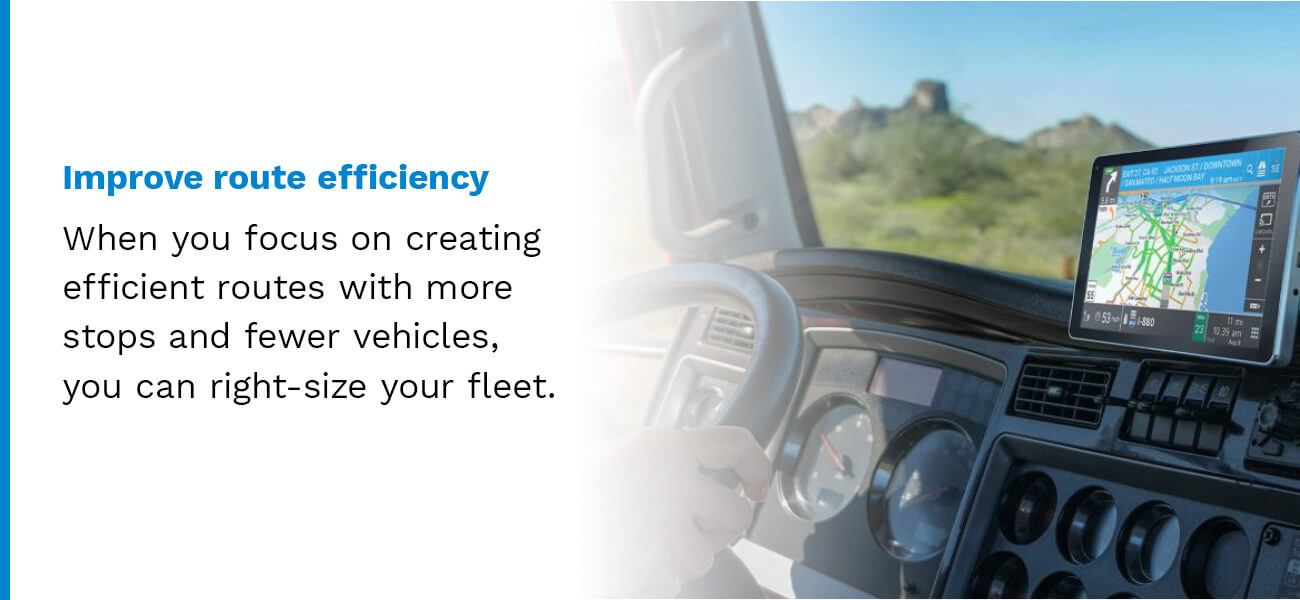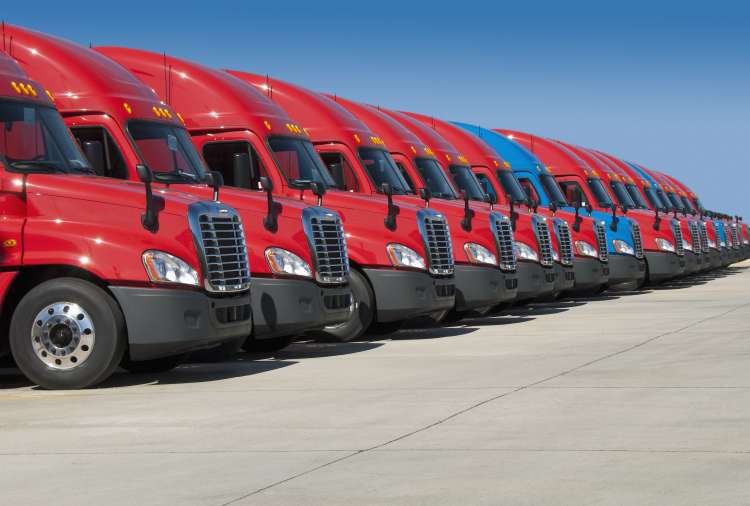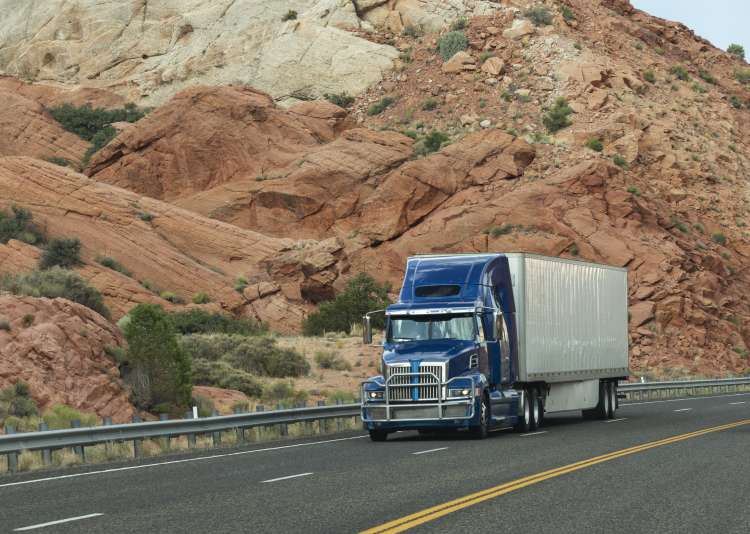How To Right-Size Your Fleet
When it comes to your fleet, growth and declines are normal fluctuations as the economy and your internal operations oscillate. As these fluctuations occur, right-sizing your fleet can help you deal with different factors that affect your overall strategy.
It can be challenging, though — maintaining your fleet size to accommodate bursts of project demands, as well as slow seasons, is at a bit of a toss-up. The goal of any company is to decrease costs while boosting profits and your bottom line.
But with precise utilization data, shorter repair times, more productive vehicles, and fleet software on hand, you can right-size your fleet. Rand McNally Fleet has fleet management solutions that can track and monitor different analytics to help you successfully downsize or upsize your operations.
What is Fleet Right-Sizing?
What does it mean to right-size your fleet? Fleet right-sizing is a management practice where you determine the best number of vehicles for your jobs. If you have too many assets, you could be expending more money than necessary. However, if you have too few, you may have an equipment shortage that can’t meet customer demands.
Right-sizing helps you form and maintain a fleet of fuel-efficient assets by calculating the number of vehicles necessary to complete your jobs — but it also goes beyond the number of vehicles. Right-sizing your fleet takes location, availability, and drivers into consideration, as well. It’s a strategic, proactive approach that can change several times throughout a single year.
As your number of clients changes, the economy shifts, your goals alternate, and your business demands rework, right-sizing can help you stay on track to minimize operational costs while driving profitability.
Benefits of Right-Sizing Your Fleet
The importance of right-sizing your fleet comes down to capital reduction or accretion, depending on your needs. A majority of a company’s budget goes toward vehicle ownership, so by getting rid of what you don’t need, you can accrue a high return on investment (ROI).
Several benefits of right-sizing your fleet include:
- Budget Savings: By identifying the precise number of vehicles you need in your fleet, you can allocate saved money to other critical business aspects.
- Emissions Reductions: A lower vehicle count attributes to a decrease in harmful emissions.
- Fuel and Maintenance Costs Reductions: With the correct number of assets in your fleet, you won’t have to spend money on unnecessary fuel and maintenance.
- Telematics Data Leveraging: Telematics information can help you see asset downtime and availability to determine how many you need for different jobs.
- Vehicle Usage Optimization: You can more effectively use the vehicles you have for a better ROI and less upfront purchase costs.
Whether you need to minimize the size of your fleet, replace machines, or add new vehicles, the right-sizing process will increase fleet efficiency, cut unnecessary costs, and create a more streamlined workflow. It will also grant you insights into the overall health of your fleet, helping you make other informed decisions regarding your future goals.
How to Right-Size Your Fleet
Fleet sizing best practices aren’t a one-time occurrence. Instead, right-sizing your fleet is a strategy you should implement as often as your operations demand. When you buy or sell vehicles, bring on more workers, or partner with additional clients, you can re-evaluate whether your fleet is accommodating or overcompensating.
Before getting started, ask the following questions:
- Does the vehicle have a low total cost of ownership?
- How often does it need maintenance?
- Is it the right size for the job?
- What’s the asset’s purpose?
Here are a few ways to right-size your fleet.
1. Asset Utilization
One approach to right-sizing your fleet is by observing fleet usage. Using a vehicle utilization report, look at the number of miles, active days, and engine hours each vehicle accrues within a day, month, or year. Create a threshold, and from there, identify vehicles and pieces of equipment that fall below that number. Which vehicles are underutilized or completely unused?
If you’re using the utilization method, make sure to categorize and analyze your assets so you’re taking other factors into account. Think about the location and worker shifts. This trick will help you see if your machines are being used according to their precise abilities.
For underutilized machines, you can sell them off and receive a high ROI. But if you have over-utilized assets, you may need to consider replacements or adding new machines to reduce costly repairs in the future. You may also find one site has more vehicles than another and it’s a simple fix of rearranging asset locations.
In some cases, backup vehicles for emergencies can be beneficial, but too many on hand can rack up your expenses.
2. Fleet Composition
On top of determining the best number of assets for your fleet, right-sizing can also include the right machines themselves. With the right mix of vehicles, you can drive profitability. Do you have a niche operation with limited diversity in your fleet or an extensive business that requires many vehicles?
3. Improve Route Efficiency
When you focus on creating efficient routes with more stops and fewer vehicles, you can right-size your fleet. Technology can assist in creating smarter dispatching and routing systems in real-time. With this information, you can effectively and efficiently use your fleet with minimal downtime during operational hours.

4. Minimize Maintenance and Repair Time and Costs
Do several of your vehicles require excessive time in the shop for repairs? By getting rid of assets that constantly need repairing, you can spend less time and money on maintenance. Instead, invest in better-performing engines to eliminate backup vehicles while increasing time on the road.
It’s important to stick to the maintenance schedule for each vehicle. You can refer to an engine’s maintenance log to see what parts have been fixed or if any replacements have been made. This detailed information can show you which assets need replacing sooner than others.
Right-sizing should be an ongoing practice that considers the following:
- Fleet composition
- Fuel
- Repair and maintenance costs
- Route efficiency
- Utilization
You’ll also want to consider the future of your business. Are your demands increasing? Will you be taking on more or different jobs? Will your locations expand? It’s critical to look at your internal trends when right-sizing to support your future efforts.
If you’re unsure when to evaluate your fleet, one of the best things you can do is check in with your crew members. Ask your drivers, maintenance technicians, and other workers about the assets they use daily and how they support or don’t support the company.
How Fleet Software Can Help
While we may think highly of ourselves enough to right-size a fleet using brainpower and handwritten notes alone, tracking, productivity, and analytics solutions can get us there faster with real-time, organized data.
Fleet software and technology come into play, helping you increase or decrease the size of your operations by offering solutions like telematics, GPS fleet tracking, and analytics. Individually, they help you understand the usage rate of each asset, along with other factors, such as:
- Compliance
- Driver behavior
- Engine faults
- Fleet composition
- Fuel economy
- Idle time
- Maintenance schedules
- Mapping
- Service alerts
- Total cost of ownership
- Vehicle tracking
Software solutions solve complex logistics, helping you make better-informed decisions, keeping you a competitive force in your industry. Some solutions even have bidding software to help you see “what-if” scenarios, along with asset utilization reports you can customize by vehicle, location, on-duty usage, time of day, and other factors.
At Rand McNally, we offer:
- Asset and fleet vehicle tracking
- Cloud routing
- Messaging and workflow software
- MileMaker software
- Navigation
- Video telematics
- Vehicle and driver analytics
- Fleet utilization reporting
- Maintenance tracking and service reminders
- Engine diagnostics and fault code reporting
Bringing on complete fleet management solutions can help you right-size your assets while keeping track of your business’s progress on many levels. The methodology for right-sizing your fleet requires keen observations using various forms of technology for support to aid you in saving money and increasing efficiency and productivity.

Request Pricing or Reach Out for A Demo
Rand McNally Fleet offers full solutions regardless of your fleet size. We are known for our best-in-class navigation technology that offers a simple installation process. If you’re right-sizing your fleet but need detailed data, our software and technology solutions can support you each step of the way.
Contact us to learn about our pricing or receive a demo of our various solutions.
Contact Rand McNally
Request Pricing for Fleet Solutions
We're looking forward to talking with you. Please fill out the form to get started.
Or call us:
+1 (800) 789-6277 (Fleet management, ELD, Asset tracking, Navigation)
+1 (800) 234-4069 x2 (MileMaker/IntelliRoute)
If you are an existing customer and need assistance, please contact your Client Success rep or email fleetsupport@randmcnally.com.
This form is for business-to-business transactions only. It is not for personal consumer use.


